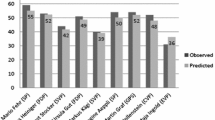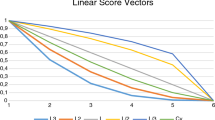Abstract
Plurality rule is mostly criticized from being capable of choosing an alternative considered as worst by a strict majority. This paper considers elections in which the agenda consists of potential candidates strategically choosing whether or not to enter the election. In this context, we examine the ability of scoring rules to fulfil the Condorcet criterion. We show for the case of three potential candidates that Plurality rule is the only scoring rule that satisfies a version of the Condorcet criterion in two cases: 1) when preferences are single-peaked and, 2) when preferences are single-dipped.
Similar content being viewed by others
Notes
Unanimity requires that if all voters find the same candidate most preferred out of the entering candidates, then that candidate is selected.
Note that in two-candidate elections, all scoring rules coincide with Majority rule.
For n sufficiently large the voting numbers can be obtained as integer numbers.
Note that when either a or c are Condorcet winner, they indeed are strong Condorcet winner.
Furthermore, it can be shown that in an endogenous election involving three candidates no scoring rule elects a Condorcet loser. By contrast Lepelley et al. [10] show, in the classical three candidate election, that a Scoring rule can elect a Condorcet loser if and only if \(0 \leqslant w <\frac{1} {2}\).
Our conjecture is that the result in Theorem 3 can be extended to any number of candidates.
These preferences are separable since alternative a is never middle-ranked.
This Theorem was suggested by an anonymous referee.
Which is defined as the conditional probability that the rule selects the Condorcet winner.
See Lepelley [8] (Sections 4 and 5) for further comments on this point. This author also provides the example P=(3, 0, 2, 2) to illustrate that candidate a is a Condorcet loser selected by Plurality rule.
These authors show by means of experiments that, under Plurality rule, pre-election polls provide coordination signals which help voters to defeat Condorcet losers.
References
Besley T, Coate S (1997) An economic model of representative democracy. Q J Econ 112:84–94
Condorcet M (1785) Éssai sur l’Application de l’Analyse à la Probabilité des Décisions Rendues à la Pluralité des Voix, Paris
Dummett M (1984) Voting procedures. Oxford University Press, Oxford
Dutta B, Jackson MO, Le Breton M (2001) Strategic candidacy and voting procedures. Econometrica 69:1013–1037
Dutta B, Jackson MO, Le Breton M (2002) Voting by successive elimination and strategic candidacy. J Econ Theory 103:190–218
Fishburn PC, Gehrlein WV (1976) Borda’s rule, positional voting and Condorcet’s simple majority principle. Public Choice 28:79–88
Forsythe R, Myerson RB, Rietz TA, Weber RJ (1993) An experiment on coordination in multi-candidate elections. Soc Choice Welf 10:223–248
Lepelley D (1993) On the probability of electing the Condorcet loser. Math Soc Sci 25:105–116
Lepelley D, Merlin V (1998) Choix social positionnel et principe majoritaire. Ann Econ Stat 51:29–48
Lepelley D, Pierron P, Valognes F (2000) Scoring rules, Condorcet efficiency and social homogeneity. Theory Decis 49:175–196
Moreno B, Puy MS (2003) Plurality Rule Works in Three-Candidate Elections. CentrA, Documento de trabajo E2003/09
Moulin H (1988) Axioms of cooperative decision making. Chapter 9. Econometric Society Monographs no 15, Cambridge University Press, Cambridge
Osborne MJ, Slivinski A (1996) A model of political competition with citizen-candidates. Q J Econ 111:64–96
Saari DG (1994) Geometry of voting. Springer, Berlin Heidelberg New York
Saari DG, Valognes F (1999) The geometry of black’s single-peakedness and related conditions. J Math E 32:429–456
Sanver MR (2002) Scoring rules cannot respect majority in choice and elimination simultaneously. Math Soc Sci 43:151–155
Woeginger G (2003) A note on scoring rules that respect majority in choice and elimination. Math Soc Sci 46:347–354
Acknowledgements
We would like to thank Pablo Amorós, Carmen Beviá, Vincent Merlin and Matthias Messner for helpful comments and suggestions. We also thank two anonymous referees for their helpful comments. Financial support from Fundación Ramón Areces and the research project SEC2002-01926 are gratefully acknowledged.
Author information
Authors and Affiliations
Corresponding author
Rights and permissions
About this article
Cite this article
Moreno, B., Socorro Puy, M. The scoring rules in an endogenous election. Soc Choice Welfare 25, 115–125 (2005). https://doi.org/10.1007/s00355-005-0034-6
Received:
Accepted:
Published:
Issue Date:
DOI: https://doi.org/10.1007/s00355-005-0034-6




